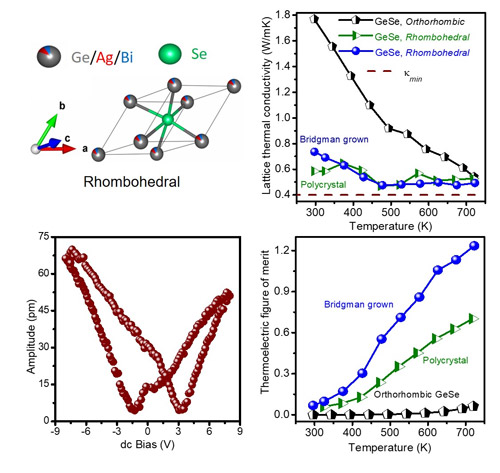 Converting waste heat to electrical energy efficiency is important for sustainable development. Scientists from Jawaharlal Nehru Centre for Advanced Research (JNCASR), an autonomous institution of the Department of Science and Technology (DST), have developed a new material for this process. High thermoelectric performance of this material is obtained from rhombohedral structure of germanium selenide, an environment-friendly inorganic solid with a unique property called ferroelectric instability.
Converting waste heat to electrical energy efficiency is important for sustainable development. Scientists from Jawaharlal Nehru Centre for Advanced Research (JNCASR), an autonomous institution of the Department of Science and Technology (DST), have developed a new material for this process. High thermoelectric performance of this material is obtained from rhombohedral structure of germanium selenide, an environment-friendly inorganic solid with a unique property called ferroelectric instability.
Nearly 65% of the energy that we utilise is irreversibly dissipated as waste heat. Thermoelectric materials can directly and reversibly convert this waste heat to useful electricity and can play a significant role in future energy management. The thermoelectric performance of a material increases significantly when its thermal conductivity decreases.
Heat through a material is mostly carried by phonons, the quanta of lattice vibration similar to photon quanta of light. Phonons can be of two types – acoustic and optical phonons. While the latter interacts with light, the former do not. The acoustic phonons are mainly responsible for heat propagation in solids, which are nothing but the sound waves in a solid. The trick to achieve high thermoelectric performance is to devise a mechanism, like putting barricades, which will interrupt the movement of these acoustic phonons and decrease the thermal conductivity.
The researchers led by Prof. Kanishka Biswas from JNCASR, Bangalore, have introduced a concept called ferroelectric instability in a thermoelectric solid germanium selenide (GeSe), which is Pb and Te free and showed that it helped achieve high thermoelectric performance.
Their research published in Journal of the American Chemical Society and supported by Science and Engineering Research Board (SERB) and DST, has shown that their newly found rhombohedral structure of GeSe exhibits ferroelectric instability, which is generating a large number of soft (low energy) optical phonons, thereby strongly scatter the heat-carrying acoustic phonons. This ultimately lowers the thermal conductivity in rhombohedral GeSe and leads to its high thermoelectric performance.
To what extent a thermoelectric material can convert the waste heat to useful electrical energy is quantified by the dimensionless figure of merit, zT, which directly depends on the materials electrical conductivity and Seebeck coefficient (the magnitude of electrical voltage generated from a given temperature gradient), and inversely depends on the thermal conductivity (the magnitude of heat conduction in the material).
“Hunt for new functional materials is the key for increased efficiency of recycling, reusing, remodeling and repurposing of waste energy and waste materials for sustainable development,” said Prof Ashutosh Sharma, Secretary, DST.
The major challenge in thermoelectrics is to fit these three apparently different material properties -- high electrical conductivity of metals, high Seebeck coefficient of semiconductors, and low thermal conductivity of glasses, into one single solid. Till date, most of the efficient thermoelectric materials use lead (Pb) or tellurium (Te) as main constituent elements which are either toxic or rare in the earth crust, limiting their use for practical applications. The introduction of ferroelectric instability in GeSe enhances thermoelectric performance that can help overcome some of these challenges, and this concept can be used for other materials as well.
Publication link: https://doi.org/10.1021/jacs.0c03696
For more details, please contact Prof. Kanishka Biswas, Email: biswas[dot]kanishka[at]gmail[dot]com; kanishka[at]jncasr[dot]ac[dot]in.






























